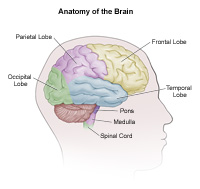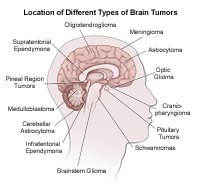Understanding Skull Base Tumors
Your ability to run, jump, write with a pen, laugh, and experience pain all start in the brain. The brain is a mass of soft tissues and nerve cells attached to the spinal cord that sends messages throughout the body to let you move and feel. The brain is divided into several parts, all protected by the skull.
 |
| Click to Enlarge |
At the base of the skull is bone that supports 4 brain components—the frontal lobe, temporal lobe, brain stem, and cerebellum.
The skull base offers support from the bottom of the brain. Think of it as the floor of the skull, where the brain sits. Five bones make up the skull base. From front to back they are:
-
Frontal
-
Ethmoid
-
Sphenoid
-
Temporal
-
Occipital
Skull base tumors
Tumors can form at the base of the skull. Or they can extend to the base of the skull after starting in another part of the body. This is called metastasis. Skull base tumors are often close to critical areas of the brain. This can make surgery hard to do and potentially dangerous.
Skull base tumors may form in many areas, including the:
 |
| Click to Enlarge |
Symptoms of skull base tumors
Symptoms will vary, depending on the origin and site of the tumor. All symptoms tend to start slowly and get worse gradually over time.
Tumors growing from the base of the cranium into the nose can cause symptoms like that of a chronic sinus infection:
Other types of skull base tumors may cause these symptoms:
Diagnosis
Skull base tumors can be diagnosed through:
Treatment
Skull base tumors are hard to treat because of their location deep inside the brain. Treatment typically includes surgery, when possible, followed by radiation therapy. Chemotherapy is sometimes used, too.
New surgical methods are currently being perfected to reach and remove skull base tumors that have been nearly unreachable through conventional surgery. One method is the endoscopic endonasal approach. It lets surgeons take out tumors through the nose. Another method is endoport surgery. The surgeon removes the tumor through a straw-like tube inserted in a tiny hole drilled in the skull. The tube is threaded into deep regions of the brain that were previously difficult, if not impossible, to reach. These and other minimally invasive procedures have led to better success rates in treating skull base cancers, with fewer complications and side effects.